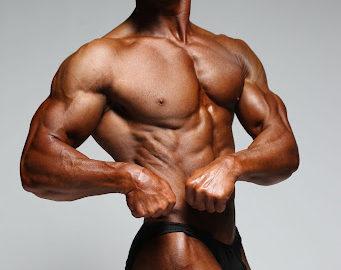Q: I’m following the arm-specialization programs in your e-book X-traordinary Arms. I like starting my biceps workout with cable curls, as you suggest, because I can add X Reps at the end of the last set. Many of the pro bodybuilders say that free weights are better for growth, so I’m worried I’m not getting the most size stimulation. Are free-weight barbell or dumbbell curls better than cable curls?
A: Not necessarily. The only problem with cable curls is weight-stack drag, which makes the negative, or lowering, stroke slightly easier; however, you get much better continuous tension with a cable curl than with barbell or dumbbell curls. That’s very important for max-growth stimulation. There’s also another big benefit.
According to Olympic coach and massive-arms expert Charles Poliquin, Japanese researchers have found that the biceps muscle responds best to faster concentric contractions. You get more biceps-muscle fibers in the action if you do the positive stroke in about one second. If you curl the weight up slowly, you tend to recruit the brachialis.
With that in mind, a cable curl becomes even more effective because you can drive the bar up in about one second without losing tension on your biceps. Not so with a barbell or dumbbells—you lose tension all over the stroke during a fast positive due to momentum. That makes the cable curl the better choice for rapid-fire sets.
To ease your mind about not using free weights, you can do cable curls at one biceps workout and dumbbell curls at the other. On dumbbell day try doing your dumbbell curls while seated on a high-incline bench. That will prevent cheating and enable you to do a fairly rapid concentric movement without losing much tension.
Here’s another tip: On cable curls use a close grip for an outer-biceps-head hit. That’s the head that produces the most peak. At the next workout the incline curls will naturally be a “wide-grip” movement—to avoid hitting your legs—and you’ll get more inner-head emphasis. The inner head creates more biceps fullness and thickness—that’s the out-for-in/in-for-out rule.
To summarize, switch from close-grip cable curls to high-incline dumbbell curls at every other arm session. You’ll emphasize each head at alternate workouts, just as the giant-arm-specialization programs in the e-book X Arms suggest, and you’ll be on your way to sleeve-stretching success.
Q: I’m using the three-way split in the basic program listed in the e-book X-traordinary X-Rep Workout. I’ve added about six pounds of muscle in only a month. My arms are larger than they’ve ever been, but I’m not satisfied with my legs. I’m doing what you guys show in your training blog, working legs only once a week on Tuesdays, with the two upper-body workouts alternating on Monday, Thursday and Friday. Should I add some leg work somewhere?
A: That’s one of the best bodypart splits you can use for mass, as there’s very little overlap. Plus, you get optimal muscle recovery and plenty of systemic recuperation. So keep the XX Workout split as you’re doing it—with legs only on Tuesday. The fix is, every other week, when back day lands on a Friday, add deadlifts for some residual leg work—like this:
Week 1
Monday: Chest, delts, triceps, abs
Tuesday: Legs
Wednesday: Off
Thursday: Back, biceps, forearms
Friday: Chest, delts, triceps, abs
Week 2
Monday: Back, biceps, forearms
Tuesday: Legs
Wednesday: Off
Thursday: Chest, delts, triceps, abs
Friday: Deadlifts, back, biceps, forearms
Repeat week 1, followed by week 2 and so on.
So at week 2—and every other week after that—your back workout falls on a Friday. That’s when you add deadlifts, and the residual leg work should give you a new blast of lower-body mass.
You may want to reduce the sets on your other back exercises on those Fridays because deadlifts are extremely taxing. They work about 80 percent of the muscles on your body, with a shocking emphasis on legs and back—plus, they provide a great overall anabolic kick.
Q: In some of your Positions-of-Flexion leg workouts you use hyperextensions for hamstrings. I thought hypers were more for lower back. Also, you call for incline one-arm lateral raises and leaning one-arm lateral raises. Aren’t incline and leaning laterals the same thing?
A: Hyperextensions are often classified as a lower-back exercise; however, if you keep your lower back flat throughout the stroke, you’ll hit your hamstrings hard with help from your glutes. Make an effort to feel your hamstrings elongate as you lower to the bottom position; force them to bear the brunt of the resistance. Remember, don’t let your lower back round at the bottom.
If you do let your lower back round, resistance will fall off the hamstrings and your lumbars will become more engaged in the action as a prime mover than as a stabilizer. So for hamstring work keep your lower back locked flat—as in stiff-legged deadlifts.
As for incline one-arm laterals, you do those with your nonworking side against an incline bench. It’s a stretch-position move in POF training because your arm moves down in front of your torso.
You perform leaning one-arm laterals by leaning out, in the opposite direction from what you do on incline laterals; for example, you put your feet next to the upright base of a crossover machine, grab the post with your nonworking arm and lean out till your support arm is straight. Then do laterals with your free arm.
Leaning laterals work more of the contracted position—the top end of the lateral-raise stroke. They provide a unique squeeze on the medial-delt head that most bodybuilders never get.
So the two exercises make a very complete routine for the medial-delt head. You get stretch with incline one-arm laterals and then contracted-position work with leaning laterals, training the full stroke against resistance. You could even superset the two for a gigantic pump.
Q: I’ve been reading a lot about low-carb diets, and I was thinking about trying one. I need to lose about 30 pounds, and getting rid of carbs seems to be the best way. What do you think?
A: Gradually reducing your carb intake is the way to go, but you don’t want to take your daily carb total too low—and never go to zero. At our lowest carb count near the end of a ripping phase, we still get around 120 grams a day.
As Jonathan Lawson, my training partner, and I say in our e-book X-treme Lean: “In general, decreasing one of the macronutrients—fat, protein or carbohydrate—to abnormally low levels isn’t the way to go for fat loss. You may lose weight, but in the case of low carbs some of it may be muscle.”
We like the carb-stacking approach, which is putting most of your daily carb allotment at breakfast and after your workout, when the muscles are depleted and will absorb most of the sugar as glycogen.
The rest of your meals should be protein dominant with very few carbs. That will force your body to burn fat for energy—and with protein circulating to feed your muscles, which you train heavy often, you don’t need to burn muscle for energy. So you get bigger and leaner. Plus, protein has a higher energy cost—it takes more energy to absorb it than carbs.
One last important tip that we’ve just realized: It’s been taking a lot longer for Jonathan and me to get lean the past few years, and after looking at our training-nutrition diaries from our best years, we now know why. The past few years we switched to a whey-only protein supplement, which spikes insulin. That turns off fat burning. Our bodies were swimming in insulin all day long, hardly ever able to burn bodyfat. We’ve switched back to a whey-micellar-casein-and-egg protein array that includes CLA, or conjugated linoleic acid, and our leanness is back on the fat track.
Editor’s note: Steve Holman is the author of many bodybuilding best-sellers and the creator of Positions-of-Flexion muscle training. For information on the POF videos and Size Surge programs, see the ad sections beginning on pages 208 and 264, respectively. Also visit www.X-Rep.com for information on X-Rep and 3D POF methods and e-books. IM




















You must be logged in to post a comment Login